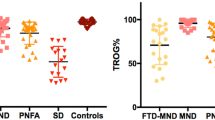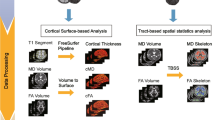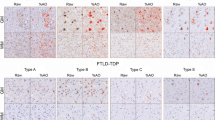Abstract
Objective
To comprehensively examine the clinical presentation of patients diagnosed with frontotemporal dementia–motor neuron disease (FTD–MND) compared to FTD subtypes. To clarify the heterogeneity of behavioural and language deficits in FTD–MND using a data-driven approach.
Methods
Patients with FTD–MND (n = 31), behavioural variant FTD (n = 119), non-fluent variant primary progressive aphasia (n = 47), semantic variant primary progressive aphasia (n = 42), and controls (n = 127) underwent comprehensive clinical, cognitive and behavioural assessments. Two-step cluster analysis examined patterns of behavioural and language impairment. Voxel-based morphometry and tract-based spatial statistics were used to investigate differences across the subgroups that emerged from cluster analysis.
Results
More than half of FTD–MND patients initially presented with variable combinations of deficits (e.g., mixed behaviour/cognitive, mixed behaviour/cognitive/motor deficits), with 74% of them meeting criteria for FTD–MND within 24 months with a median of 12 months. The frequency and severity of behavioural and language abnormalities in FTD–MND lie between that seen in the three FTD phenotypes. Cluster analysis identified three patterns of behavioural and language impairment in FTD–MND. The three FTD–MND subgroups demonstrated different profiles of white matter tract disruption, but did not differ in age at onset, disease duration or patterns of cortical atrophy.
Conclusions
While highly heterogeneous, in terms of behavioural and language deficits, and disease severity, the presentation of FTD–MND may be distinct to that of FTD. Distinct white matter degeneration patterns may underpin heterogeneous clinical profiles in FTD–MND. FTD presenting with mixed behavioural-language disturbances should be monitored closely for at least 12–24 months for the emergence of MND symptoms/signs.


Similar content being viewed by others
Data availability
Anonymized data not published within the article will be shared on reasonable request from a qualified investigator for replication purposes.
References
Ahmed RM, Devenney EM, Strikwerda-Brown C, Hodges JR, Piguet O, Kiernan MC (2020) Phenotypic variability in ALS–FTD and effect on survival. Neurology 94:e2005–e2013
Andersson JL, Jenkinson M, Smith S (2007) Non-linear registration, aka spatial normalisation FMRIB technical report TR07JA2. FMRIB Anal Group Univ Oxf 2:1–21
Benton AL, Hamsher KD (1983) Multilingual aphasia examination: manual of instructions. In: Department of Neurology and Psychology, University of Iowa, Iowa City
Bowie CR, Harvey PD (2006) Administration and interpretation of the Trail Making Test. Nat Protoc 1:2277–2281
Brooks BR, Miller RG, Swash M, Munsat TL (2000) El Escorial revisited: revised criteria for the diagnosis of amyotrophic lateral sclerosis. Amyotroph Lateral Scler Other Motor Neuron Disord 1:293–299
Burrell JR, Halliday GM, Kril JJ, Ittner LM, Götz J, Kiernan MC, Hodges JR (2016) The frontotemporal dementia–motor neuron disease continuum. Lancet 388:919–931
Burrell JR, Kiernan MC, Vucic S, Hodges JR (2011) Motor neuron dysfunction in frontotemporal dementia. Brain 134:2582
Chare L, Hodges JR, Leyton CE, McGinley C, Tan RH, Kril JJ, Halliday GM (2014) New criteria for frontotemporal dementia syndromes: clinical and pathological diagnostic implications. J Neurol Neurosurg Psychiatry 85:865–870
Coon E, Sorenson E, Whitwell J, Knopman D, Josephs K (2011) Predicting survival in frontotemporal dementia with motor neuron disease. Neurology 76:1886–1892
Croot K, Hodges JR, Patterson K (1999) Evidence for impaired sentence comprehension in early Alzheimer’s disease. J Int Neuropsychol Soc 5:393–404
de Carvalho M, Dengler R, Eisen A, England JD, Kaji R, Kimura J, Mills K, Mitsumoto H, Nodera H, Shefner J, Swash M (2008) Electrodiagnostic criteria for diagnosis of ALS. Clin Neurophysiol 119:497–503
Elamin M, Bede P, Byrne S, Jordan N, Gallagher L, Wynne B, O’Brien C, Phukan J, Lynch C, Pender N (2013) Cognitive changes predict functional decline in ALS a population-based longitudinal study. Neurology 80:1590–1597
Gorno-Tempini ML, Hillis AE, Weintraub S, Kertesz A, Mendez M, Cappa SF, Ogar JM, Rohrer JD, Black S, Boeve BF, Manes F (2011) Classification of primary progressive aphasia and its variants. Neurology 76:1006–1014
Harris JM, Jones M, Gall C, Richardson AM, Neary D, du Plessis D, Pal P, Mann DM, Snowden JS, Thompson JC (2016) Co-occurrence of language and behavioural change in frontotemporal lobar degeneration. Dementia Geriatr Cogn Disord Extra 6:205–213
Hodges JR (2007) Cognitive assessment for clinicians. Oxford University Press, Oxford
Hodges JR (2017) Cognitive assessment for clinicians, 3rd edn. Oxford University Press, Oxford
Hodges JR, Davies R, Xuereb J, Kril J, Halliday G (2003) Survival in frontotemporal dementia. Neurology 61:349–354
Hsieh S, Caga J, Leslie FV, Shibata M, Daveson N, Foxe D, Ramsey E, Lillo P, Ahmed RM, Devenney E (2016) Cognitive and behavioral symptoms in ALSFTD: detection, differentiation, and progression. J Geriatr Psychiatry Neurol 29:3–10
Hsieh S, Schubert S, Hoon C, Mioshi E, Hodges JR (2013) Validation of the Addenbrooke’s Cognitive Examination III in frontotemporal dementia and Alzheimer’s disease. Dement Geriatr Cogn Disord 36:242–250
Hu WT, Seelaar H, Josephs KA, Knopman DS, Boeve BF, Sorenson EJ, McCluskey L, Elman L, Schelhaas HJ, Parisi JE (2009) Survival profiles of patients with frontotemporal dementia and motor neuron disease. Arch Neurol 66:1359–1364
Kamminga J, Leslie FV, Hsieh S, Caga J, Mioshi E, Hornberger M, Ballard KJ, Kiernan MC, Hodges JR, Burrell JR (2016) Syntactic comprehension deficits across the FTD–ALS continuum. Neurobiol Aging 41:11–18
Leslie FV, Hsieh S, Caga J, Savage SA, Mioshi E, Hornberger M, Kiernan MC, Hodges JR, Burrell JR (2015) Semantic deficits in amyotrophic lateral sclerosis. Amyotroph Lateral Scler Frontotemporal Degener 16:46–53
Lezak M, Howieson D, Bigler E, Tranel D (2012) Neuropsychological assessment, 5th edn. Oxford University Press, New York
Lillo P, Mioshi E, Burrell JR, Kiernan MC, Hodges JR, Hornberger M (2012) Grey and white matter changes across the amyotrophic lateral sclerosis-frontotemporal dementia continuum. PLoS ONE 7:e43993
Mioshi E, Dawson K, Mitchell J, Arnold R, Hodges JR (2006) The Addenbrooke’s Cognitive Examination Revised (ACE-R): a brief cognitive test battery for dementia screening. Int J Geriatr Psychiatry 21:1078–1085
Mioshi E, Hsieh S, Savage S, Hornberger M, Hodges JR (2010) Clinical staging and disease progression in frontotemporal dementia. Neurology 74:1591–1597
Montuschi A, Iazzolino B, Calvo A, Moglia C, Lopiano L, Restagno G, Brunetti M, Ossola I, Presti AL, Cammarosano S (2015) Cognitive correlates in amyotrophic lateral sclerosis: a population-based study in Italy. J Neurol Neurosurg Psychiatry 86:168–173
Mooi E, Sarstedt M (2011) Cluster analysis. A concise guide to market research. Springer, Berlin
Neary D, Snowden JS, Gustafson L, Passant U, Stuss D, Black S, Freedman M, Kertesz A, Robert PH, Albert M, Boone K, Miller BL, Cummings J, Benson DF (1998) Frontotemporal lobar degeneration: a consensus on clinical diagnostic criteria. Neurology 51:1546–1554
Nichols TE, Holmes AP (2002) Nonparametric permutation tests for functional neuroimaging: a primer with examples. Hum Brain Mapp 15:1–25
Ogar J, Slama H, Dronkers N, Amici S, Luisa Gorno-Tempini M (2005) Apraxia of speech: an overview. Neurocase 11:427–432
Omer T, Finegan E, Hutchinson S, Doherty M, Vajda A, McLaughlin RL, Pender N, Hardiman O, Bede P (2017) Neuroimaging patterns along the ALS–FTD spectrum: a multiparametric imaging study. Amyotroph Lateral Scler Frontotemporal Degener 18:611–623
Osterrieth PA (1944) Le test de copie d'une figure complexe; contribution a l'etude de la perception et de la memoire. Archives de psychologie
Piguet O, Hornberger M, Mioshi E, Hodges JR (2011) Behavioural-variant frontotemporal dementia: diagnosis, clinical staging, and management. Lancet Neurol 10:162–172
Rascovsky K, Hodges JR, Knopman D, Mendez MF, Kramer JH, Neuhaus J, Van Swieten JC, Seelaar H, Dopper EG, Onyike CU (2011) Sensitivity of revised diagnostic criteria for the behavioural variant of frontotemporal dementia. Brain 134:2456–2477
Sarstedt M, Mooi E (2014) Cluster analysis. A concise guide to market research. Springer, Heidelberg
Savage S, Hsieh S, Leslie F, Foxe D, Piguet O, Hodges JR (2013) Distinguishing subtypes in primary progressive aphasia: application of the Sydney language battery. Dement Geriatr Cogn Disord 35:208–218
Schmidt M (1996) Rey auditory verbal learning test: a handbook. Western Psychological Services, Los Angeles
Scotter EL, Chen H-J, Shaw CE (2015) TDP-43 proteinopathy and ALS: insights into disease mechanisms and therapeutic targets. Neurotherapeutics 12:352–363
Smith SM (2002) Fast robust automated brain extraction. Hum Brain Mapp 17:143–155
Smith SM, Jenkinson M, Johansen-Berg H, Rueckert D, Nichols TE, Mackay CE, Watkins KE, Ciccarelli O, Cader MZ, Matthews PM (2006) Tract-based spatial statistics: voxelwise analysis of multi-subject diffusion data. Neuroimage 31:1487–1505
So M, Foxe D, Kumfor F, Murray C, Hsieh S, Savage G, Ahmed RM, Burrell JR, Hodges JR, Irish M, Piguet O (2018) Addenbrooke’s Cognitive Examination III: psychometric characteristics and relations to functional ability in dementia. J Int Neuropsychol Soc JINS 24:1–10
Strauss E, Sherman EM, Spreen O (2006) A compendium of neuropsychological tests: administration, norms, and commentary. American Chemical Society, Washington, DC
Strong MJ, Abrahams S, Goldstein LH, Woolley S, Mclaughlin P, Snowden J, Mioshi E, Roberts-South A, Benatar M, HortobáGyi T (2017) Amyotrophic lateral sclerosis-frontotemporal spectrum disorder (ALS–FTSD): revised diagnostic criteria. Amyotroph Lateral Scler Frontotemporal Degener 18:153–174
Strong MJ, Abrahams S, Goldstein LH, Woolley S, Mclaughlin P, Snowden J, Mioshi E, Roberts-South A, Benatar M, HortobáGyi T (2017) Amyotrophic lateral sclerosis-frontotemporal spectrum disorder (ALS-FTSD): revised diagnostic criteria. Amyotroph Lateral Scler Frontotemporal Degener 18(3–4):153–174. https://doi.org/10.1080/21678421.2016.1267768
Van Langenhove T, Piguet O, Burrell JR, Leyton C, Foxe D, Abela M, Bartley L, Kim WS, Jary E, Huang Y (2017) Predicting development of amyotrophic lateral sclerosis in frontotemporal dementia. J Alzheimer’s Dis 58:163–170
Wear HJ, Wedderburn CJ, Mioshi E, Williams-Gray CH, Mason SL, Barker RA, Hodges JR (2008) The Cambridge behavioural inventory revised. Dement Neuropsychol 2:102–107
Wedderburn C, Wear H, Brown J, Mason SJ, Barker RA, Hodges J, Williams-Gray C (2008) The utility of the Cambridge Behavioural Inventory in neurodegenerative disease. J Neurol Neurosurg Psychiatry 79:500–503
Yim O, Ramdeen KT (2015) Hierarchical cluster analysis: comparison of three linkage measures and application to psychological data. Quant Methods Psychol 11:8–21
Zhang Y, Brady M, Smith S (2001) Segmentation of brain MR images through a hidden Markov random field model and the expectation-maximization algorithm. IEEE Trans Med Imaging 20:45–57
Acknowledgements
We are grateful to the research participants and their families.
Funding
This work was supported by funding to Forefront, a collaborative research group dedicated to the study of frontotemporal dementia and motor neuron disease, from the National Health and Medical Research Council of Australia (NHMRC) program Grant (#1037746) and the Australian Research Council Centre of Excellence in Cognition and its Disorders Memory Node (#CE110001021). In addition, JRB was supported by a NHMRC Early Career Fellowship (#1072451). MI is supported by an ARC Future Fellowship (FT160100096). OP is supported by a NHMRC Senior Research Fellowship (APP1103258).
Author information
Authors and Affiliations
Corresponding author
Ethics declarations
Conflicts of interest
The authors report no competing interests.
Ethical approval
The study was approved by the ethics committees of the University of New South Wales and South Eastern Sydney Local Health District. In accordance with the Declaration of Helsinki, written informed consent was obtained from all participants, or their carers.
Supplementary Information
Below is the link to the electronic supplementary material.
Rights and permissions
About this article
Cite this article
Long, Z., Irish, M., Foxe, D. et al. Heterogeneity of behavioural and language deficits in FTD–MND. J Neurol 268, 2876–2889 (2021). https://doi.org/10.1007/s00415-021-10451-7
Received:
Revised:
Accepted:
Published:
Issue Date:
DOI: https://doi.org/10.1007/s00415-021-10451-7




